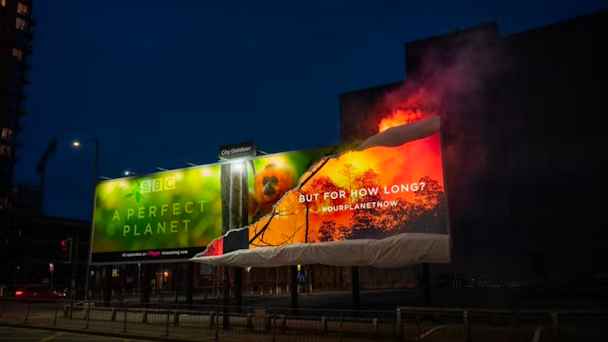How the industry must tackle digital advertising’s massive carbon footprint in 2023
While most marketers express concern over climate change, programmatic advertising’s formidable carbon footprint persists. As part of our Data and Privacy Deep Dive, sustainability experts outline what needs to be done.

Adland is grappling with its emissions problem / BBC
The average consumer may not realize just how much goes into placing the targeted ads they receive online every day. Nor are they aware of the abundant carbon emissions the process emits.
While it may not be as quantifiable as other sectors, the advertising industry is a major driver of climate change. Programmatic advertising – defined as the automated buying and selling of online ads – may be one of the biggest digital culprits, with automated bids happening in the thousands every second of every day. The Drum tapped executives at Ad Net Zero, OpenX, Good-Loop and Gordon & Frost to weigh in on the issue.
Digital advertising’s massive carbon footprint explained
From the impact of day-to-day business to the electricity spent serving consumers targeted, auctioned impressions, the ways in which adland impacts the environment are myriad.
The typical online ad campaign emits about 5.4 tons of carbon dioxide, according to GoodLoop's carbon calculator. For a little perspective, that represents about half of the total annual impact of an inhabitant of the UK. In fact, each digital ad impression can produce up to 1.09 grams of CO2 before offsetting, per the peer-reviewed scientific article Environmental Impact Assessment of Online Advertising.
Advertisement
“When you sum the trillions of digital impressions we place as an industry every year, that’s a lot of CO2,” says Ryan Gordon, co-founder and head of strategy at Gordon & Frost, a sustainability-minded media agency.
The process by which ads get placed in front of consumers is not only complicated but also carbon-intensive at every step, he says. “After extensive strategy and planning, marketplace assessment, selection of vendors, creation and deployment of actual assets, some of the more electricity-expensive parts of the process take place. This includes programmatic media buying and selling, with real-time, down-to-the-nanosecond, auction-based bidding among thousands of advertisers and suppliers, leveraging a vast array of data providers and different partners throughout the supply chain, each vying for that opportunity to win [or sell] that placement.
“And while thousands, or more, may bid on that single impression – each attempt expending energy – only one can actually win the impression.”
Indeed, the programmatic ecosystem uses a surprising amount of computing power and, adds Ad Net Zero’s US director John Osborn, “as more and more advertising dollars continue to shift to the digital and performance arena, we see this trend continuing, unless there are serious steps to mitigate and curb that carbon impact.”
Advertisement
The ad industry needs a crash course in environmental education
The carbon cost of online advertising does not go unnoticed. In fact, it’s something the industry almost unanimously seeks to eradicate. A survey that purpose-led adtech company Good-Loop published in September found that 76% of marketers believe the advertising industry is not doing enough to address the carbon cost of online ad campaigns. However, the industry has a long way to go. Over half of marketers say their organization plans to reach net zero in digital advertising at some point, but only 24% have set targets and just 2% say they have already reached net zero.
So, what’s the hold-up? Experts cite three reasons: a lack of industry-wide standardization, regulation and education. “We’re not climate scientists; we’re advertisers,” says Amy Williams, co-founder and chief executive of Good-Loop. “We need collaboration [and] a simple education that makes everybody feel confident in the space.”
Once the industry attains a “greater understanding of the issues at hand ... the changes we seek to make as an industry can be coordinated, impactful and measurable,” adds Gordon. “Ultimately, properly aligning incentives is a key aspect of successfully affecting these changes.”
Looking to create real change by 2030
Adland unequivocally ought to be further along in adopting more sustainable practices; however, it would also be untrue to say that progress hasn’t already been made.
One such initiative is Ad Net Zero. The collective aims to decarbonize the advertising industry by 2030, as well as develop a data framework to measure – and subsequently address – advertising’s contribution to climate change. “Our goal is real action and real behavior change as soon as humanly possible,” says Osborn. “The Ad Net Zero community is growing, sharing best practices, learning together and collaborating to identify the very best way forward when it comes to sustainability.”
Indeed, many brands and agencies are leading by example, making aggressive strides toward sustainable practices. Enter OpenX, a cloud-based advertising data exchange that reports having reduced its carbon emissions by over 96% between 2018 and 2021 and has been carbon neutral-certified by Climate Impact Partners.
“We’ve seen a lot of progress in the last few years as the industry moves toward more sustainable business practices,” says John Gentry, chief executive of Open X. “At this stage, while some brands and agencies are sophisticated in their approach to sustainability, the industry would benefit broadly from a focus on education and alignment with global sustainability standards.”
Advertisement
In addition to rallying behind the industry-wide systemic change, Gordon recommends that agencies can start their sustainability journey by making internal changes. “Optimize your work streams and processes, opt for a phone call instead of a full trip, reduce file size where possible, optimize local storage over cloud storage [and] reduce the number of redundancies in file versions, to name just a few examples.”
While there is still ample progress to make in advertising’s sustainability journey, it’s imperative that brands and marketers continue to unite and decarbonize their supply chains. The industry and the planet depend on it.
For more on how the world of data-driven advertising and marketing is evolving, check out our latest Deep Dive.
